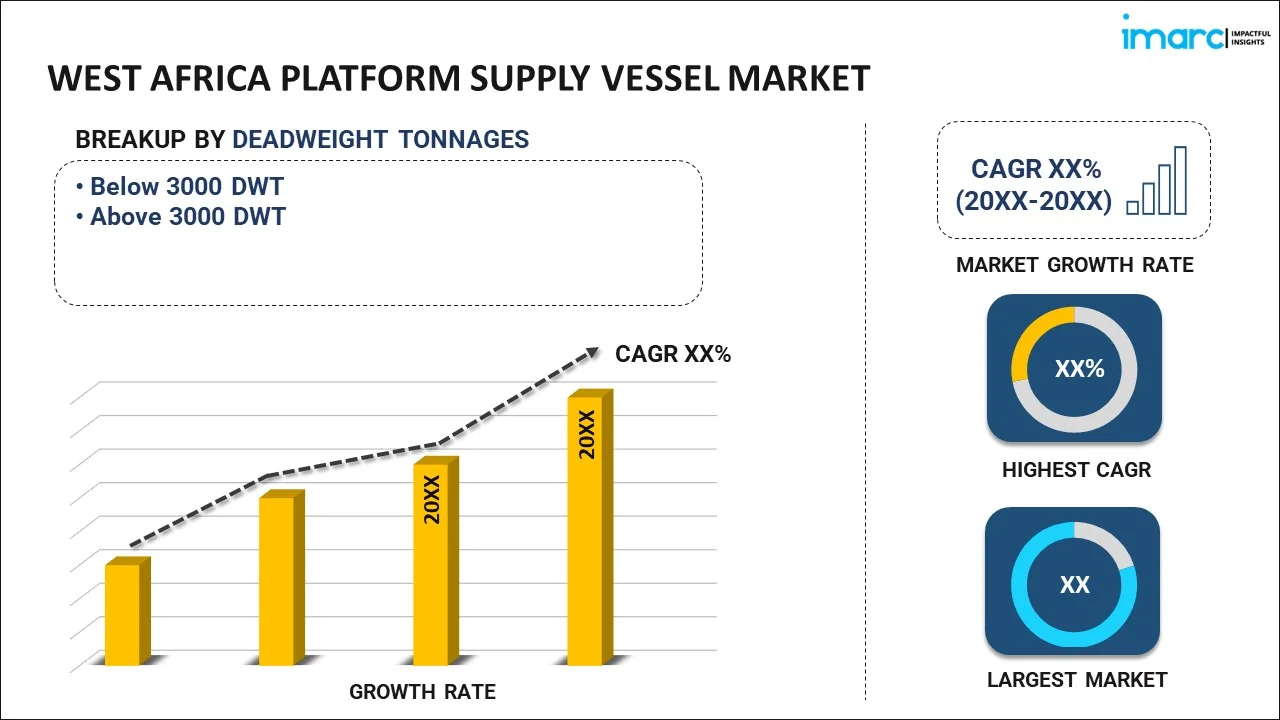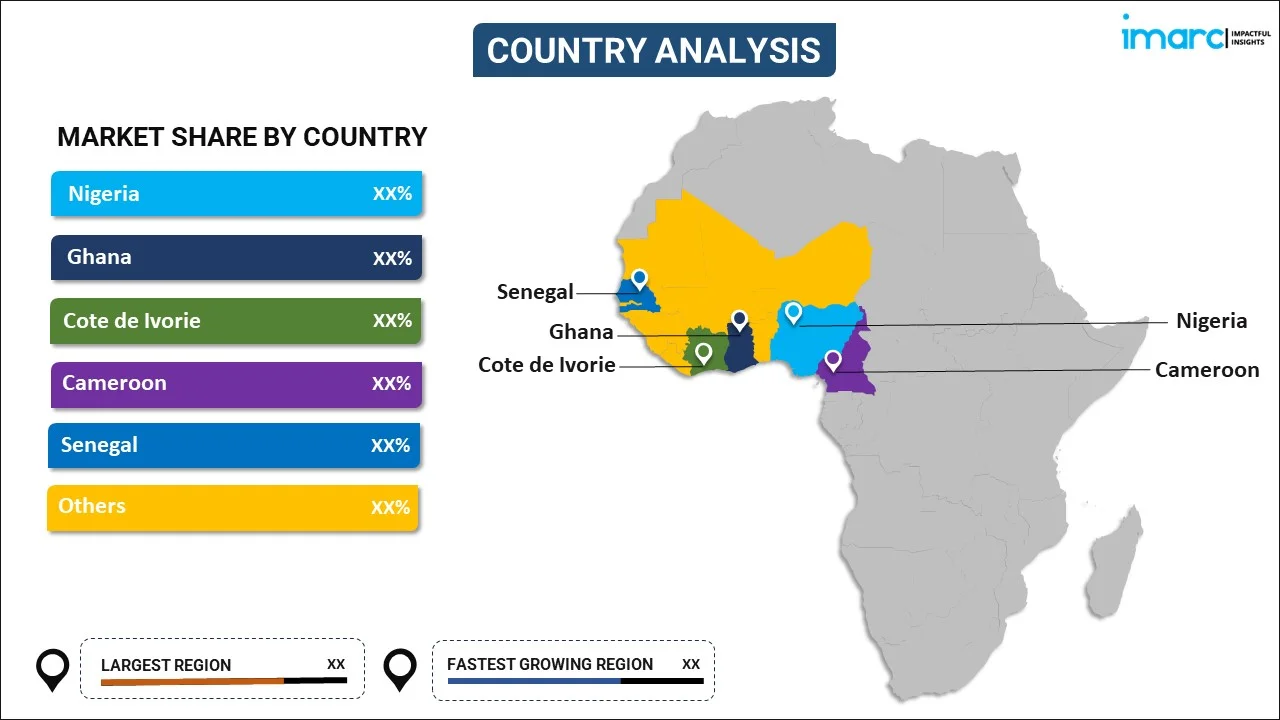
West Africa Platform Supply Vessel Market Report by Deadweight Tonnage (Below 3000 DWT, Above 3000 DWT), Fuel Type (Diesel, LNG, and Others), Application (Oil and Gas Production, Offshore Construction, Military, and Others), and Country 2024-2032
Market Overview:
The West Africa platform supply vessel market size is projected to exhibit a growth rate (CAGR) of 1.58% during 2024-2032. The increasing exploration and production activities in the region, rising deep-water and ultra-deep-water drilling activities, implementation of regulatory frameworks and government initiatives, rapid technological advancements, and the growing prevalence of mergers and partnerships represent some of the key factors driving the market.
|
Report Attribute
|
Key Statistics
|
|---|---|
|
Base Year
|
2023 |
|
Forecast Years
|
2024-2032
|
|
Historical Years
|
2018-2023
|
| Market Growth Rate (2024-2032) | 1.58% |
Platform supply vessels (PSVs) refer to specialized marine vessels that are designed to transport goods to and from offshore oil and gas platforms. They are engineered to be multifunctional and capable of carrying a wide range of supplies, such as drilling fluids, cement, fuel, food, spare parts, and equipment for offshore explorations. Platform supply vessels are inherently robust, adaptable, and capable of withstanding extreme weather conditions, manufactured from high-strength steel and other advanced composite materials. They include small, medium, and large-sized vessels, each with unique capacities and functionalities. Platform supply vessels are employed in oil drilling, offshore wind farms, sub-sea construction, and salvage operations. They offer numerous benefits, such as enhanced logistical efficiency, reduction in offshore operational time, improved safety measures, and better supply chain management. Additionally, platform supply vessels offer fuel efficiency, high cargo-carrying capacities, advanced navigational systems for better route optimization, crew amenities, cost-effective operations, and adaptability to different offshore conditions.
West Africa Platform Supply Vessel Market Trends:
The increasing exploration and production activities in the region’s offshore oil and gas sector are creating a positive outlook for the market growth. In line with this, the growing demand for PSVs to facilitate the complex logistical requirements of various operations is bolstering the market growth. Additionally, the rising deep-water and ultra-deep-water drilling activities, leading to the need for advanced and larger PSVs equipped with state-of-the-art navigational and cargo-handling capabilities, are anticipated to drive the market growth. Moreover, the implementation of regulatory frameworks and government initiatives, boosting offshore oil and gas operations, is positively impacting the market growth. Along with this, rapid technological advancements, like the adoption of digital twin technology and artificial intelligence (AI)-driven data analytics that optimize operational efficiencies, making the PSVs more adaptable and cost-effective, are strengthening the market growth. Furthermore, the growing focus on sustainability in the shipping industry, prompting the production of eco-friendly PSVs utilizing alternative fuels like LNG or battery-hybrid systems, is favoring the market growth. Besides this, the increasing prevalence of mergers and partnerships aimed at reducing operational costs and enhancing services is stimulating the market growth. Apart from this, the emergence of local shipbuilding capacities and the transfer of technology are creating new opportunities for the market growth. In confluence with this, the increasing foreign investments in the West African offshore sector, fueling the need for state-of-the-art PSVs, is offering remunerative growth opportunities for the market. Besides this, the incorporation of emerging technologies, such as dynamic positioning systems, to ensure safer and more efficient operation, is bolstering the market growth.
West Africa Platform Supply Vessel Market Segmentation:
IMARC Group provides an analysis of the key trends in each segment of the market, along with forecasts at the regional and country levels for 2024-2032. Our report has categorized the market based on deadweight tonnage, fuel type, and application.
Deadweight Tonnage Insights:

- Below 3000 DWT
- Above 3000 DWT
The report has provided a detailed breakup and analysis of the market based on the deadweight tonnage. This includes below 3000 DWT and above 3000 DWT.
Fuel Type Insights:
- Diesel
- LNG
- Others
A detailed breakup and analysis of the market based on the fuel type have also been provided in the report. This includes diesel, LNG, and others.
Application Insights:
- Oil and Gas Production
- Offshore Construction
- Military
- Others
The report has provided a detailed breakup and analysis of the market based on the application. This includes oil and gas production, offshore construction, military, and others.
Country Insights:

- Nigeria
- Ghana
- Cote de Ivorie
- Cameroon
- Senegal
- Others
The report has also provided a comprehensive analysis of all the major regional markets, which include Nigeria, Ghana, Cote de Ivorie, Cameroon, Senegal, and Others.
Competitive Landscape:
The market research report has also provided a comprehensive analysis of the competitive landscape in the market. Competitive analysis such as market structure, key player positioning, top winning strategies, competitive dashboard, and company evaluation quadrant has been covered in the report. Also, detailed profiles of all major companies have been provided.
West Africa Platform Supply Vessel Market Report Coverage:
| Report Features | Details |
|---|---|
| Base Year of the Analysis | 2023 |
| Historical Period | 2018-2023 |
| Forecast Period | 2024-2032 |
| Units | US$ Million |
| Scope of the Report | Exploration of Historical and Forecast Trends, Industry Catalysts and Challenges, Segment-Wise Historical and Predictive Market Assessment:
|
| Deadweight Tonnages Covered | Below 3000 DWT, Above 3000 DWT |
| Fuel Types Covered | Diesel, LNG, Others |
| Application Covered | Oil and Gas Production, Offshore Construction, Military, Others |
| Countries Covered | Nigeria, Ghana, Cote de Ivorie, Cameroon, Senegal, Others |
| Customization Scope | 10% Free Customization |
| Report Price and Purchase Option | Single User License: US$ 3699 Five User License: US$ 4699 Corporate License: US$ 5699 |
| Post-Sale Analyst Support | 10-12 Weeks |
| Delivery Format | PDF and Excel through Email (We can also provide the editable version of the report in PPT/Word format on special request) |
Key Questions Answered in This Report:
- How has the West Africa platform supply vessel market performed so far and how will it perform in the coming years?
- What has been the impact of COVID-19 on the West Africa platform supply vessel market?
- What is the breakup of the West Africa platform supply vessel market on the basis of deadweight tonnage?
- What is the breakup of the West Africa platform supply vessel market on the basis of fuel type?
- What is the breakup of the West Africa platform supply vessel market on the basis of application?
- What are the various stages in the value chain of the West Africa platform supply vessel market?
- What are the key driving factors and challenges in the West Africa platform supply vessel?
- What is the structure of the West Africa platform supply vessel market and who are the key players?
- What is the degree of competition in the West Africa platform supply vessel market?
Key Benefits for Stakeholders:
- IMARC’s industry report offers a comprehensive quantitative analysis of various market segments, historical and current market trends, market forecasts, and dynamics of the West Africa platform supply vessel market from 2024-2032.
- The research report provides the latest information on the market drivers, challenges, and opportunities in the West Africa platform supply vessel market.
- Porter's five forces analysis assist stakeholders in assessing the impact of new entrants, competitive rivalry, supplier power, buyer power, and the threat of substitution. It helps stakeholders to analyze the level of competition within the West Africa platform supply vessel industry and its attractiveness.
- Competitive landscape allows stakeholders to understand their competitive environment and provides an insight into the current positions of key players in the market.
Need more help?
- Speak to our experienced analysts for insights on the current market scenarios.
- Include additional segments and countries to customize the report as per your requirement.
- Gain an unparalleled competitive advantage in your domain by understanding how to utilize the report and positively impacting your operations and revenue.
- For further assistance, please connect with our analysts.
 Inquire Before Buying
Inquire Before Buying
 Speak to an Analyst
Speak to an Analyst
 Request Brochure
Request Brochure
 Request Customization
Request Customization




.webp)




.webp)












